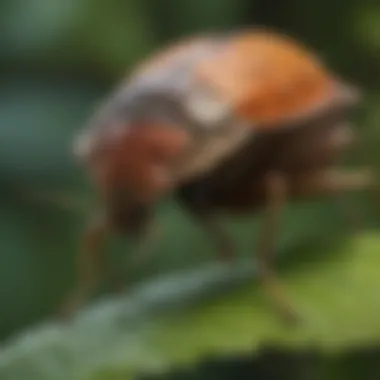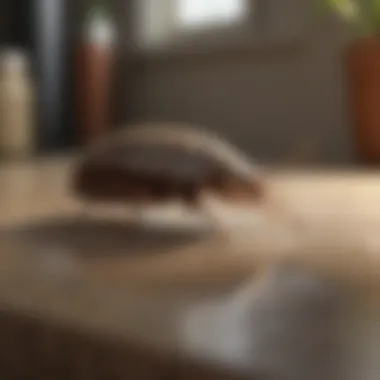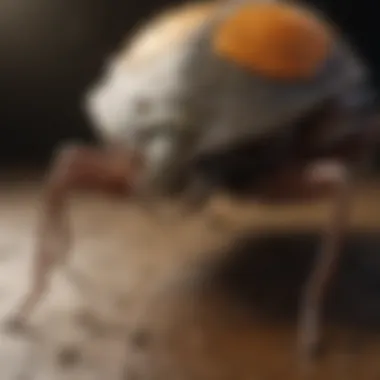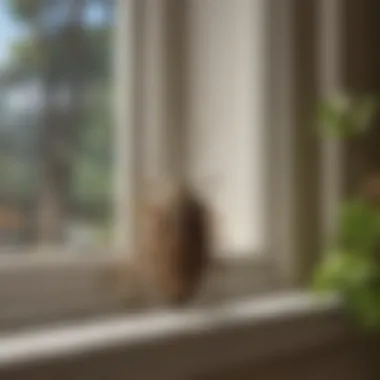Effective Strategies for Removing Stink Bugs from Your Home


Intro
Stink bugs are a persistent nuisance for many homeowners. Understanding how to effectively manage their presence is vital in maintaining a comfortable living space. This article explores the methods to remove stink bugs from your home, focusing on identification, prevention strategies, and treatment options. By gaining insight into their behavior and lifecycle, homeowners can develop practical solutions to address infestations.
Pest Identification
Identifying stink bugs is the first step toward effectively managing an infestation.
Detailed Descriptions of Common Pests
The brown marmorated stink bug, a common household pest, is known for its shield-like shape. Adults typically measure around 1.5 centimeters long and have a mottled brown coloration with lighter stripes on the antennae. Additionally, these pests emit a distinctive odor when disturbed, contributing to their name.
Signs and Symptoms of Infestations
Homeowners should be aware of various signs of stink bug infestations, which include:
- Visible bugs: Finding stink bugs indoors, particularly near windows or light sources.
- Odor: A foul smell, often described as rotten, is a strong indicator of their presence.
- Damage to plants: Check for yellowing leaves or wilting branches, especially on indoor plants or those near outside walls.
"Early detection is critical in preventing further infestations and damage to your home."
Prevention Strategies
Implementing effective prevention strategies can significantly reduce the likelihood of stink bugs entering your home.
Home Maintenance Tips for Pest Prevention
Taking proactive measures around your home is essential. Consider the following tips:
- Seal entry points: Inspect windows, doors, and vents for gaps. Use caulk to seal cracks and ensure screens are well-fitted.
- Reduce outdoor attractants: Clear debris, clippings, and leaves from around the home. These can attract stink bugs.
- Maintain indoor cleanliness: Regularly vacuum and clean surfaces to avoid food sources that may draw stink bugs indoors.
Natural Deterrents and Barriers
Utilizing natural deterrents can help keep stink bugs at bay. Some options include:
- Essential oils: Peppermint and garlic oils can be used as sprays to deter stink bugs.
- Diatomaceous earth: Sprinkling this natural substance around entry points may deter pests without harming your indoor environment.
Treatment Options
If stink bugs manage to enter your home, various treatment options are available to tackle the issue effectively.
Overview of Chemical vs. Natural Treatments
Choosing between chemical and natural treatments depends on personal preference and the severity of the infestation.
- Chemical treatments: Insecticides specifically designed for stink bugs can provide immediate results but may pose risks to pets or children.
- Natural treatments: Using homemade sprays made from soap and water or essential oils offers a safer alternative.
Step-by-Step Guides for DIY Treatments
For those opting for DIY methods, follow these guidelines:
- Soap and water spray: Combine approximately two tablespoons of liquid soap with a spray bottle of water. Target stink bugs directly when visible.
- Essential oil mix: Mix water with a few drops of peppermint or garlic oil in a spray bottle. Apply around entry points.
Understanding Stink Bugs
Understanding Stink Bugs is pivotal in effectively managing their presence in homes. These pests are not just an annoyance; they can cause real distress for homeowners. Knowing their habits, behaviors, and life cycles aids in crafting realistic and impactful removal strategies. This section will provide an overview of stink bugs, delve into their biology and behaviors, and discuss their life cycle. By grasping these aspects, homeowners can significantly increase their chances of preventing infestations and implementing more effective control methods.
Overview of Stink Bugs
Stink bugs, primarily the brown marmorated stink bug, are invasive insects originating from Asia. They have become widespread in the United States and other regions. Identifiable by their shield-like shape and brown coloration, the adult bugs often gather in the fall, seeking shelter in homes for the winter. The name "stink bug" comes from the foul odor they release when threatened or crushed. This odor serves as a defense mechanism and can be quite overpowering, making their presence even more unwelcome in households.


Key Characteristics:
- Shape: Shield-shaped body
- Color: Mostly brown, sometimes with mottled patterns
- Size: Ranges from 1/2 inch to 3/4 inch long
- Odor: Releases a strong smell when disturbed
Understanding these characteristics assists homeowners in identifying stink bugs before they become too numerous.
Biology and Behavior
Stink bugs possess interesting biological traits. They are members of the Pentatomidae family and are defined as true bugs due to their unique mouthparts that allow them to pierce and suck plant juices. These pests are primarily herbivorous, feeding on fruits and plants. However, their behavioral patterns are equally significant in addressing infestations.
Their typical behavior includes congregating in large numbers in sheltered locations as the weather cools. Stink bugs prefer warm, sunny environments, making homes particularly attractive during fall. They can often be found in attics, wall voids, and hidden spots around windows and doors. Such behaviors highlight the need for preventative strategies aimed at sealing off potential entry points.
Life Cycle of Stink Bugs
The life cycle of stink bugs consists of three main stages: egg, nymph, and adult. Understanding this cycle is essential for effective management.
- Egg Stage: Female stink bugs lay clusters of eggs, typically on the underside of leaves. Each cluster can contain 20 to 30 eggs.
- Nymph Stage: Upon hatching, nymphs emerge as small, wingless versions of adults. They go through several molts, becoming larger and developing their distinctive features.
- Adult Stage: After about a month, nymphs mature into adults, capable of reproduction and furthering the cycle.
Managing infestations entails interrupting this life cycle through targeted removal and preventive measures.
Being aware of these stages allows homeowners to time their removal strategies effectively. For instance, addressing infestations in the nymph stage may yield better results than waiting until they become adults.
Identifying Stink Bug Infestations
Identifying a stink bug infestation is a crucial step in managing these pests effectively. Recognizing the signs early can help prevent a small problem from escalating into a larger issue. Stink bugs are notorious for their ability to invade homes seeking shelter, especially during colder months. Understanding how to identify their presence allows homeowners to take prompt action, minimizing damage and discomfort.
Signs of Infestation
Several key indicators suggest that stink bugs have settled into your home. Recognizing these signs is important for effective intervention.
- Visible Presence: The most obvious sign of an infestation is seeing stink bugs themselves. These insects are about 1-2 cm in length and have a distinctive shield-like shape, often brown or gray.
- Foul Odor: Stink bugs emit a pungent odor when they are disturbed. If you notice an unusual smell, particularly in certain rooms, it could suggest their presence.
- Droppings: Tiny, dark droppings on surfaces can be a telltale sign of stink bugs. If you find small, round excrement near window sills or corners, it may be time to investigate further.
- Egg Cases: Adult stink bugs lay clusters of eggs, which are usually yellow or green in color. Finding these egg cases can indicate an active infestation.
Monitoring these signs closely helps to mitigate the situation before it worsens.
Common Hiding Spots
Stink bugs are adept at finding places to hide within homes. Understanding where they commonly reside can help with both identification and removal strategies.
- Cracks and Crevices: Stink bugs prefer to hide in small spaces. Check cracks in walls, gaps around windows, and edges of doors where they may enter.
- Attics and Basements: These areas are often overlooked but can serve as excellent hiding spots due to their relative darkness and seclusion. Inspecting attics during autumn can reveal their presence before they migrate into living spaces.
- Near Warm Appliances: Stink bugs are drawn to warmth. Therefore, places near stoves, heaters, or other warm appliances should be monitored.
- Underneath Furniture: They may take refuge under couches, beds, or large pieces of furniture. Regular cleaning and inspections can uncover their hidden locations.
Important: The earlier you can identify stink bug signs and common hiding spots, the better chance you have of controlling their presence effectively.
These identification methods aid in swift action against infestations, creating a more comfortable living environment.
Preventative Measures
Preventative measures are crucial for managing stink bugs effectively. Understanding how to deter these pests before they invade your home can save considerable effort and resources later on. Proactive strategies minimize the chances of infestation, ensuring your living environment remains comfortable. Implementing preventative measures focuses on reducing the factors that attract stink bugs, securing entry points, and maintaining your yard effectively. Each element contributes to a comprehensive defense against these unwanted visitors.
Sealing Entry Points
Sealing entry points is one of the most effective strategies to prevent stink bugs from entering your home. These pests often seek shelter during colder months, and houses offer a warm refuge. Inspect your home for gaps, cracks, and openings around windows, doors, and walls.
- Windows and Doors: Ensure that screens are intact and use weatherstripping to seal gaps. Consider caulking any visible cracks.
- Foundation and Walls: Inspect the foundation for cracks. Fill them with appropriate materials. Pay attention to weep holes and vents that may provide access.
- Utility Openings: Areas where utilities enter your home also require sealing. Use silicone caulk to fill any small gaps.
By addressing these entry points, you greatly reduce the chances of stink bugs making their way indoors.
Outdoor Maintenance Tips
Maintaining your yard can significantly impact the likelihood of stink bugs invading your home. Proper outdoor management limits their habitat and reduces potential food sources. Consider these tips for effective outdoor maintenance:
- Remove Debris: Clear away any leaf litter, plant debris, or grass clippings, as these can serve as hiding spots.
- Landscape Management: Trim back vegetation that touches your home. Stink bugs often use these plants as highways to enter homes.
- Proper Composting Practices: If you compost, use sealed bins to limit access to potential food sources. Stink bugs are attracted to various organic materials.


A well-kept yard discourages these pests from even considering your home as a habitat.
Managing Yard Attractants
Specific yard attractants draw stink bugs to your home. Understanding and managing these can form a key part of your preventative strategy.
- Plant Selection: Be mindful of the plants you choose for your garden. Some, like certain fruits and vegetables, may attract stink bugs. It's better to opt for plants that are less appealing.
- Pesticide Use: When using pesticides, target treatments to minimize unintended attractions. Overuse can lead to a rise in pest population.
- Trash Management: Store trash in tightly sealed containers. Stink bugs are often drawn to odors that emanate from rubbish bins.
By controlling and managing these attractants, you create an environment that is less inviting for stink bugs, thereby preventing their entry into your home.
By taking these preventative measures, not only do you protect your home from stink bugs, but you also create a healthier living environment.
Implementing effective preventative measures lays the groundwork for successful stink bug management. Each step you take now can lead to significant benefits later.
Natural Removal Methods
Natural removal methods play a significant role in managing stink bug infestations in homes. These methods emphasize the use of non-toxic, environmentally friendly solutions that pose less risk to humans and pets. Homeowners increasingly prefer these techniques as they avoid harsh chemicals and consider health implications. Furthermore, they maintain the integrity of the home's ecosystem and facilitate routine pest control without the need for professional interventions.
Essential Oil Repellents
Essential oils have gained attention for their ability to repel pests, including stink bugs. Oils like peppermint, eucalyptus, and tea tree are particularly effective due to their strong scents. To use essential oils as repellents, simply dilute them with water in a spray bottle and apply the solution around entry points and areas where stink bugs are often seen.
- Peppermint Oil: Known for its strong aroma, it effectively disrupts the sense of smell that stink bugs rely on.
- Eucalyptus Oil: This oil contains compounds that are unappealing to various insects, making it a preferred choice.
- Tea Tree Oil: Often recognized for its antiseptic properties, tea tree oil also acts as a deterrent.
To enhance effectiveness, reapply the essential oil solution weekly or after heavy rain. However, it’s important to test the mixture on surfaces first to avoid damage.
Vinegar Solutions
Vinegar is another effective natural remedy. White vinegar, in particular, not only helps in repelling stink bugs but can also kill some upon contact. Mix equal parts of water and vinegar in a spray bottle for best results.
- Application: Spray directly on stink bugs or in areas where they are likely to enter. The strong, acetic scent of vinegar disorients and repels them, reducing their presence.
- Dissipation: Vinegar will evaporate and leave behind no residue, making it a safe option for indoor application.
- Frequency: Regular application is recommended, especially during periods when stink bugs are more active, such as during fall migration.
This simple, cost-effective solution can significantly mitigate the problem if used consistently.
Homemade Traps
Creating homemade traps is an inventive method to capture stink bugs effectively. These traps can be easily assembled using common household items. One popular trap exploits light attraction.
- Light Trap: Fill a shallow pan with soapy water and place it under a light source such as a desk lamp. Stink bugs are drawn to the light but will fall into the water and drown.
- Sugar Water Trap: Mix 1 part sugar to 3 parts water in a jar. The sweet scent attracts stink bugs, and they become trapped inside.
- Bottle Trap: Cut the top off a plastic bottle and invert it. Place a piece of fruit or vegetables inside to lure stink bugs in. They can enter but find it difficult to escape.
Setting these traps strategically around the home can gradually reduce the stink bug population. Regular checks and maintenance of traps are vital to ensure effectiveness.
Using natural removal methods not only addresses the stink bug problem but also contributes to a healthier home environment by avoiding harmful chemicals.
By exploring and applying these natural techniques, homeowners can feel empowered to manage pest control in a safe manner.
Chemical Removal Solutions
Chemical removal solutions are crucial for households dealing with stink bug infestations. While natural methods can be effective to some extent, severe infestations often require a more aggressive approach. Chemical solutions offer benefits that include immediate results and the ability to target specific areas where stink bugs have taken refuge.
However, it is essential to approach chemical removal with caution. Understanding the types of insecticides available, the methods of application, and the necessary safety precautions can help ensure success while minimizing risks to your family and pets.
Insecticides Overview
Insecticides are chemical agents designed to kill insects. For stink bug removal, several active ingredients are effective, including pyrethroids, neonicotinoids, and insect growth regulators. Each type has its strengths:
- Pyrethroids: These are widely used due to their rapid action. They disrupt the nervous system of the insect, leading to death within a short period.
- Neonicotinoids: These affect the central nervous systems of insects. They are often used for long-term treatment as they provide residual effects.
- Insect Growth Regulators: These do not kill stink bugs immediately but disrupt their life cycle, preventing them from maturing or reproducing.
Choosing an insecticide often depends on the extent of the infestation and the user's preferences regarding speed and long-lasting effects.


Application Methods
The effectiveness of chemical removal largely depends on proper application. Here are common methods:
- Spraying: This is the most direct method. Use a spray bottle or a garden sprayer for wider coverage. Apply the insecticide around windows, doors, and potential entry points.
- Fogging: This method disperses the insecticide in the form of fog or mist. It is effective in enclosed spaces, covering a large area quickly.
- Granules: These can be scattered in areas where stink bugs are likely to travel. Granules are especially useful for outdoor applications.
When applying any chemical agents, always follow the manufacturer’s instructions carefully. This ensures both effectiveness and safety.
Safety Precautions
Safety is paramount when using chemical solutions. Here are essential precautions:
- Protective Equipment: Wear gloves, masks, and goggles during application to prevent contact with skin and inhalation of fumes.
- Ventilation: Ensure that rooms are well-ventilated. Open windows and doors to allow fresh air circulation while the insecticides are applied.
- Keep Away from Pets and Children: After application, restrict access to treated areas for pets and children. Wait for a specified period before re-entering, as outlined in the product instructions.
- Dispose Properly: Dispose of any empty containers and excess materials according to local regulations to avoid environmental contamination.
"The use of chemical solutions requires care, but they are often necessary for complete stink bug removal."
Professional Pest Control
Professional pest control services offer a vital solution when dealing with stubborn stink bug infestations. While homeowners can implement various natural and chemical methods, sometimes the problem may escalate beyond personal capabilities. This is where the decision to seek professional intervention becomes essential. Pest control experts bring expertise and specialized tools that can effectively eliminate stink bugs, ensuring peace of mind. Furthermore, they often understand the behavioral patterns of these pests, which can lead to a more comprehensive solution.
When to Seek Professional Help
Recognizing when to call for expert assistance is critical for effective pest management. Here are some indicators that suggest it might be time to enlist professional help:
- Severe Infestation: If you observe a significant number of stink bugs, not just a few wandering around, it's an indication that the problem has escalated.
- Ineffective DIY Methods: When home remedies or commercial products fail to manage the infestation, it signals the need for a more robust solution.
- Time Constraints: Busy homeowners may not have the time to deal with persistent problems. Professionals can provide quick and efficient solutions.
- Damage Concerns: Stink bugs can cause more than just unpleasant odors. If their presence threatens plants or household items, immediate action is warranted.
Choosing a Pest Control Service
Selecting the right pest control service is crucial for effective management. Here are some factors to consider:
- Reputation and Reviews: Look for services with positive feedback from previous clients. Online platforms, like Reddit or local directories, can offer insights into their reliability.
- License and Insurance: Ensure the service is properly licensed and insured. This is a sign of professionalism and accountability.
- Methods of Treatment: Inquire about the methods they use. It's important to choose a service that employs safe and effective techniques, respecting both your home and the environment.
- Warranty and Follow-up Services: A reputable service often provides warranties for their work and subsequent follow-ups to ensure the problem is fully resolved.
In summary, pest management is an ongoing process. Understanding when to seek professional help and how to choose the right service is key to maintaining a stink bug-free home.
Long-Term Prevention Strategies
Long-term prevention strategies are essential in managing stink bug populations over time. Understanding that these pests can become a recurring issue, it is vital to implement practices that reduce the likelihood of reinfestations and minimize their presence in and around your home. This not only saves time and effort in dealing with these pests but also enhances the comfort of living spaces and protects valuable household items from damage.
These strategies involve a combination of monitoring, habitat modification, and seasonal adjustments. Each element plays a role in contributing to an environment that is less hospitable to stink bugs. Keeping a clean and well-maintained home can significantly lower the chances of encountering these pests.
Monitoring for Reinfestation
Regular monitoring for reinfestation is a proactive measure that involves checking for signs of stink bugs at various times throughout the year. After initial removal efforts, homeowners should remain vigilant and inspect areas where stink bugs frequently invade. This includes entrances, windows, and basements, as well as outdoor locations near the house.
- Visual Inspections: Check the exterior of your home and entry points for any visible stink bugs. Look under eaves, around windows, and doors.
- Bug Traps: Using sticky traps can help catch lingering stink bugs and provide insight into their population status. Place these traps near suspected entry points or areas where you’ve noticed previous activity.
- Record Keeping: Keeping detailed notes on the frequency and locations of stink bug sightings can help identify patterns and areas that require special attention.
"Regular monitoring not only aids in recognizing an infestation early but also reinforces prevention efforts, making it easier to manage future challenges."
Seasonal Considerations
Seasonal changes significantly influence stink bug behavior and activity. Be aware that stink bugs tend to become more active during specific times of the year. Recognizing these patterns allows for timely intervention.
- Fall: This season marks the onset of stink bug activity as they search for shelter before the winter. During this time, sealing entry points becomes crucial.
- Winter: Stink bugs often enter a dormant state, hiding in walls and insulation. However, checking for any late arrivals before winter fully sets in can help reduce their numbers.
- Spring: With the increase of warmth, stink bugs become active again, leading to potential reinfestation. Utilizing early detection methods during spring can prevent larger outbreaks.
- Summer: Inspect outdoor spaces regularly, ensuring that landscaping does not attract stink bugs. Seasonal yard maintenance can help eliminate potential attractants.
Employing these long-term prevention strategies will provide homeowners with a robust framework for managing stink bug populations effectively. By integrating regular monitoring and understanding seasonal behavior patterns, the efforts made towards a stink bug-free home will yield more successful and lasting outcomes.
Epilogue
In the management of stink bugs, understanding effective strategies for removal and prevention is crucial. This article has outlined a range of methods that homeowners can adopt to not only deal with existing infestations but to also minimize the chances of future occurrences. Whether through natural solutions or chemical treatments, knowledge always empowers effective action. Each approach presented also aligns with health and safety considerations, catering to the needs of families and pets.
Recap of Key Points
- Stink bugs can invade homes through small openings. Sealing these entry points is an essential first step in prevention.
- Identifying signs of infestation early can prevent more severe problems later. Look for their characteristic smell and droppings.
- Various natural methods, such as using essential oils and vinegar solutions, can deter stink bugs without chemical risks.
- Chemical insecticides can be effective but must be applied carefully, considering safety for residents and pets.
- Professional pest control services can be an option if infestations persist beyond home remedies. They offer expertise and solutions tailored to individual situations.
- Continuous monitoring and seasonal considerations are key to long-term management, ensuring that homes remain pest-free.
Final Thoughts on Stink Bug Management
Effectively managing stink bugs requires a multi-faceted approach tailored to each home’s unique circumstances. Homeowners must be diligent about prevention, identification, and removal techniques. Being proactive reduces the likelihood of infestations, while proper response strategies ensure that if they do arise, they are swiftly and effectively dealt with. Engaging with the methods discussed, one can successfully maintain a comfortable living environment free from the disruption of these pests. Prioritizing safe, effective solutions will lead to overall satisfaction and peace of mind.



